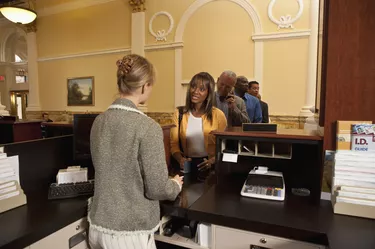
The time after the death of a family member or spouse can be challenging. Not only must you face emotional issues but there are also practical legal and financial realities that cannot be avoided. Luckily, closing bank accounts after death is relatively easy to do and need not distract you from other responsibilities during this time.
Step 1
The first step is to contact the bank, preferably by phone, to notify them of the account holder's death. The bank will inform you of the forms of official notification they require before they can take action on the account. It will be necessary to comply with the particular bank's policies to close the account after death.
Video of the Day
Step 2
It will most likely necessary to obtain an original or certified copy of the person's death certificate. A death certificate is a document issued by a state government agency that provides information about an individual's death. Depending on the manner of death, this can be a law enforcement coroner, a state-licensed private entity or the state registrar. Death certificates are public record and, once issued, can be obtained by anyone from a state registrar's office.
Step 3
If the decedent was the recipient of Social Security payments, you can also use the Social Security Administration's (SSA) designation as proof of death. Usually it takes much longer for the SSA to discontinue payments than it does for a death certificate to be generated. But if the financial institution was the depository in which the benefits were electronically deposited, the entry of the death notification entry (DNE) code will satisfy the bank that the individual has in fact died.
Step 4
In addition to proving the account holder's death to the bank, it will also be necessary to prove documentation of your own authority to act with regard to the bank account. The document can be a letters testamentary from a probate court that designate you as personal representative of the estate. If you are named beneficiary of a payable-on-death account, you will have to provide personal identification.
Step 5
Direct the bank on how to disburse funds. If the money in the account is to be disbursed to a separate account for the estate, you will need to provide a routing and account number for an electronic transfer. A named beneficiary to the account can receive a bank check payable to them directly.
Step 6
Submit joint account forms. If you are the spouse of the deceased, you will have the same access to the account you shared as you did previously. However, to take advantage of certain death benefits, you will need to submit the same documentation as described above, as well as forms specific to your joint account. It may be necessary, for example, to cash out a CD early without penalty. It will probably also be necessary to remove the deceased's name from the account.
Tip
The personal representative usually takes the initiative in obtaining the death certificate and notifying banks, even when there are payable-on-death accounts. A payable-on-death account is one that allows the account holder to name beneficiaries who receive the proceeds of the account without having to go through probate. The funds will have to be disbursed before the account can be closed.
Video of the Day